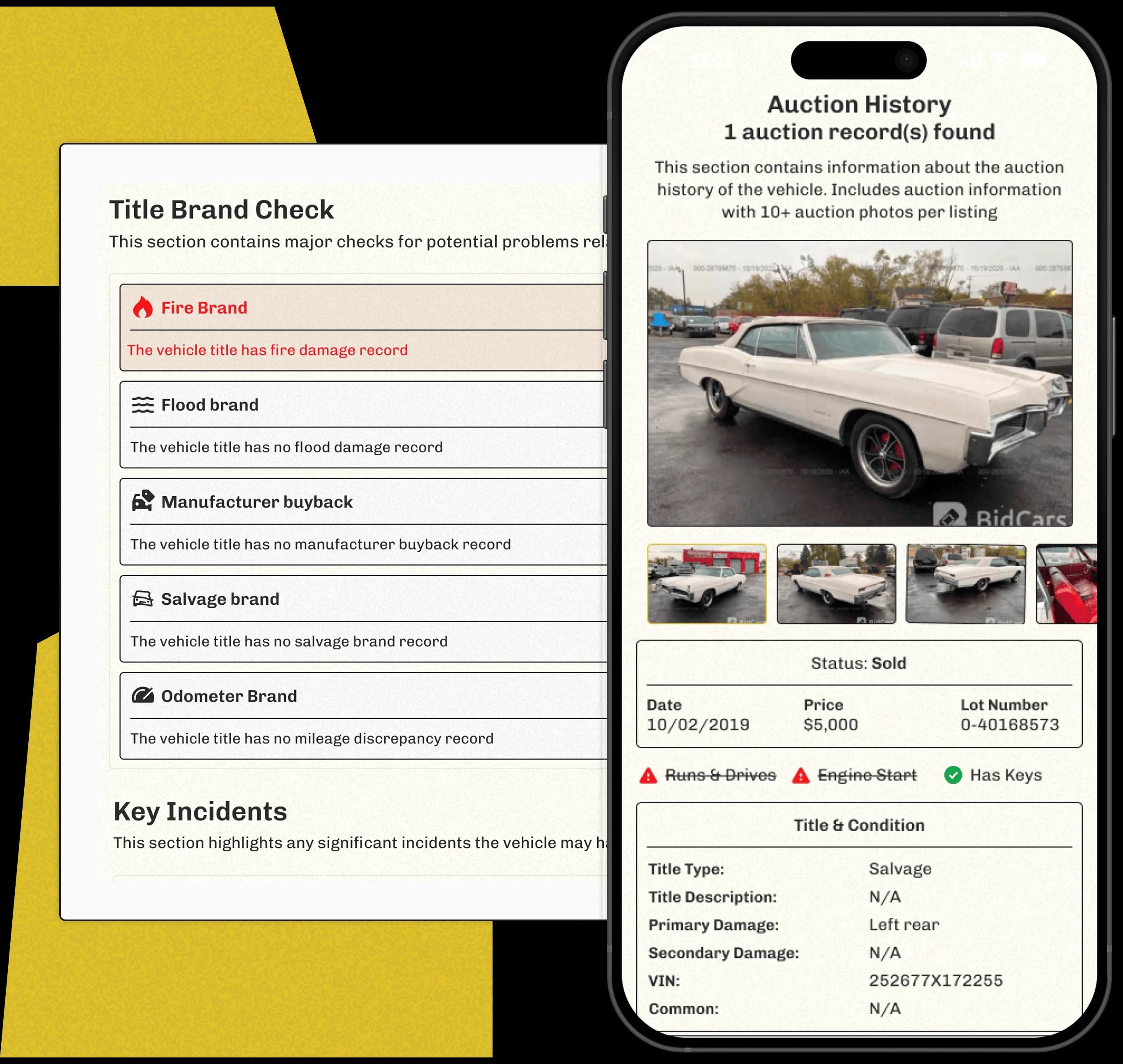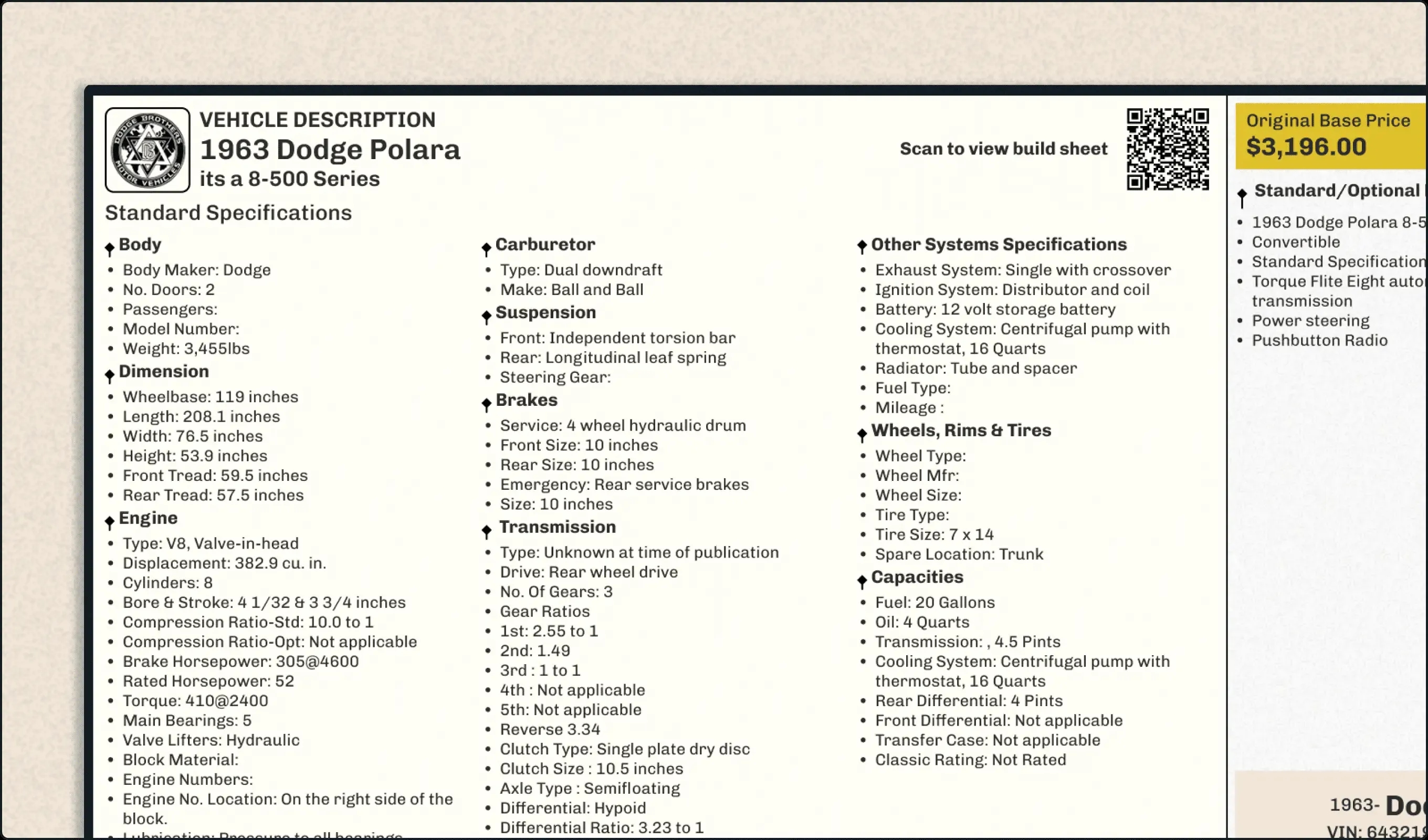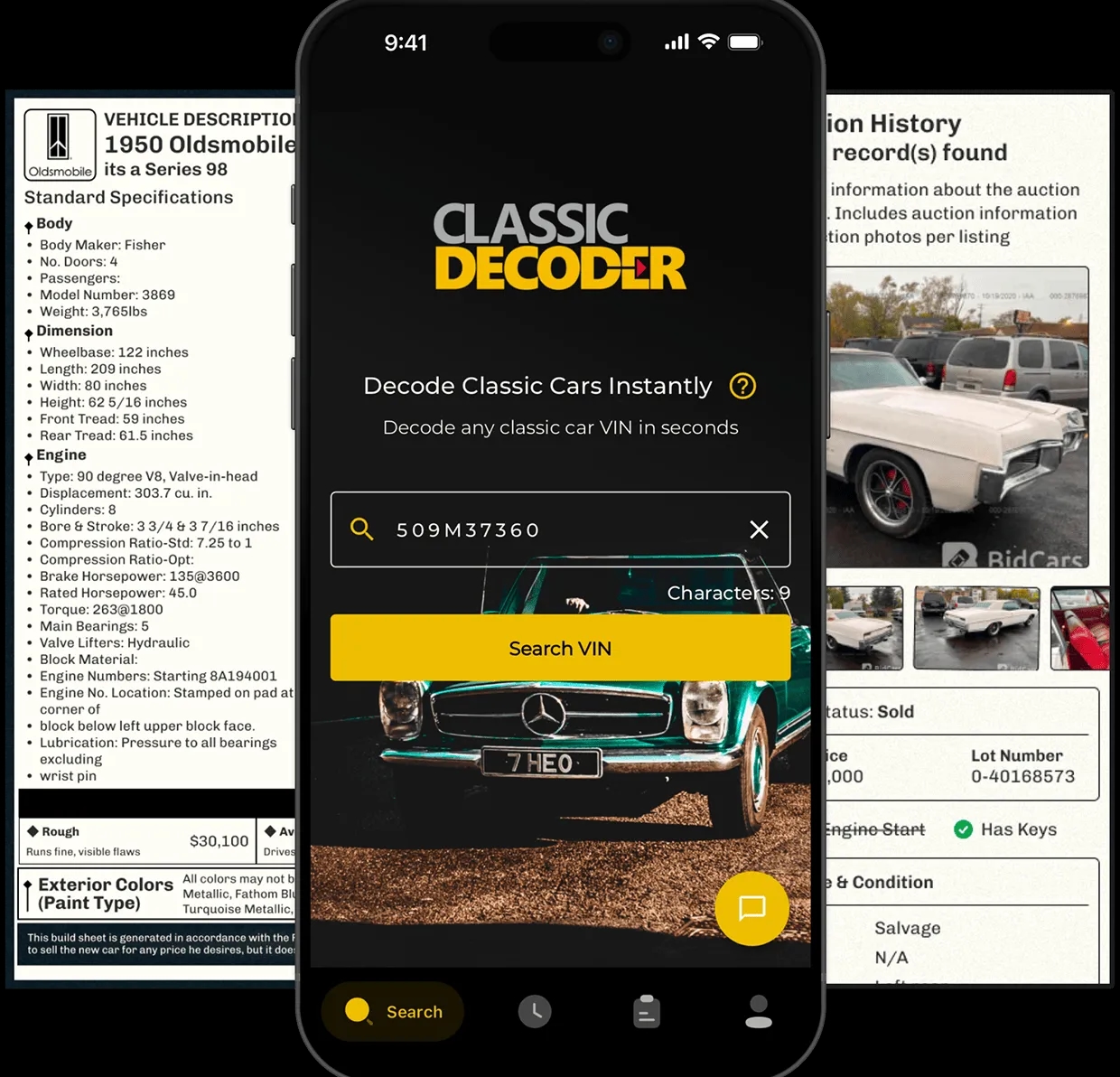1951 Dodge Coronet
The 1951 Dodge Coronet: a stylish post-war cruiser! Its sleek lines and chrome accents were a hit, representing a move towards more modern design. A solid, reliable car reflecting the optimism of the era, it wasn't flashy but undeniably cool. Think classic American style on the road.
Decode Classic VINs to Get Vehicle History Report and Build Sheet
The 1951 Dodge Coronet: A Classic Car Icon
When it comes to classic cars, the 1951 Dodge Coronet is one of those gems that enthusiasts cherish. Whether you're new to the classic car scene or a seasoned collector, understanding the for models like the 1951 Dodge Coronet is essential.

1951 Dodge Coronet Models:
Select the vehicle's model to see the correct data for it.
How Much is Dodge Coronet Worth?
Original MSRP :$2,206.00
Outstanding
Clean
Average
Rough
1951 Dodge Coronet Specs
Interested in buying a classic car or selling one?
Access detailed history reports for classic vehicles from hundreds of manufacturers.
- Accident Records
- Theft Records
- Loan & Lien Information
- Auction Information
- Salvage Information and more

History of the 1951 Dodge Coronet
The Dodge Coronet's story begins in a post-World War II America, keen on elevating style and performance. Introduced amidst fierce competition, the Coronet boasted a robust V8 engine that set it apart from many contemporaries. A low grille and sculpted bonnet added distinctive aesthetic appeals, while its engineering catered to both family-friendly practicality and the thrill-seeking racer.
Learn more about a classic car: Get Build Sheet by VIN.
Access reproduced classic build sheets to learn more about your classic vehicle details.
- Standard Specifications
- Original Base Price
- Standard & Optional Equipment
- Exterior & Interior Colors
- VIN ID & Location description

1951 Dodge Coronet Detailed Specifications
Under the hood, the 1951 Coronet packed a punch. Equipped with options that included a V8, the classic car was designed for both daily driving and performance events. If you're curious about tracing its history, a can offer insights into past ownership and modifications.
Popular Figures Who Own the 1951 Dodge Coronet
Perhaps one of the most fascinating aspects of the Coronet is its association with Hollywood glamour.
Betty Hutton
Known for her energetic film performances during the 40s and 50s, actress Betty Hutton also made headlines owning a 1951 Coronet. Her ownership added a sprinkle of star power to the Dodge Coronet's allure.
John Robert Powers
This name might ring a bell if you're into modeling history. John Robert Powers, a modeling mogul, was among the elite who owned this classic. It's not just about cars; it's about culture—having a Coronet was a stylish statement in his day.
Dorothy Dandridge
Also among Coronet's distinguished owners was actress Dorothy Dandridge. Her iconic presence in the Hollywood elite during the mid-20th century contributed to the Coronet's celebrity status.
Fun Facts about the 1951 Dodge Coronet
Sibling Rivalry: It competed fiercely with rivals like the Oldsmobile Rocket 88 for supremacy in the burgeoning muscle car era.
Price Points: The classic car market values these models variably, with sales as high as $14,000 depending on the model's condition.
Pop Culture: Appearing in films and TV, the Coronet reinforced images of rebellion and adventure, making it more than just a car but a cultural icon.
Interested in Buying or Selling a Classic Car?
Whether you're looking to purchase or offload that coveted Coronet, it's important to have the right documentation:
Accident Records
Theft Records
Loan & Lien Information
Auction Information
Salvage Information and more
Conclusion
In the world of classic automobiles, the 1951 Dodge Coronet stands out not just for its engineering but for its cultural impacts. From the canvas roofs etched in celebrity lore to the robust engines under the hood, every mile of its history invites further exploration—sometimes it's not just a car, you know, it's an experience.
Need to dig deeper? Consider using resources like a or even a for those pre-1981 models. It's all about keeping the journey vibrant and the history alive.
Classic VIN Decoder App |Now available on both Android and iOS!
At Classic Decoder, we believe that developing a mobile app is a great way to extend our classic car data solution hub to as many users as possible across the globe. Our app is built with users and precision in mind. It holds the key to unlocking the history and details of any retro car at your fingertips. It also comes with fascinating and user-friendly features that make it stand out from other mobile apps designed for this purpose.
The Classic Decoder app lets you decode and lookup any classic VIN in a flash. Access accurate vehicle information and history, make an informed decision faster, and buy and trade in classic cars with confidence.

Download The Classic Decoder App now.
Some unique features include:
- Support all classic VIN lengths from 5 to 13 digits
- Support classic cars produced from 1910 – 1980
- Online Garage features – to add and manage your vehicles
- 24/7 Customer Support
- Easy onboarding for first-time users
Explore Dodge Coronet from Other Years
Frequently Asked Questions
Well, let's see... the '51 Coronet's got some pretty neat styling cues that set it apart. Think of it like this: it's a bit of a departure from previous years, you know? You'll notice the sweeping lines along the body, a really smooth, aerodynamic look for its time; that's something that really pops. Plus, those iconic chrome bumpers – oh boy, are they shiny! And the grille, that's a standout feature too; a real head-turner, especially given the design trends back then. It really had some jazzy features. Overall, it's a really distinctive design for its era. You won't mistake it for anything else, even from a distance, and it's why I love them. They have their own personality.
The 1951 Dodge Coronets came with a couple of engine choices, if I remember correctly. There was a 230 cubic inch flathead six, that was a pretty standard option, reliable workhorse. Think of it like the dependable family sedan of the engine world. But then, there was also a more powerful 251 cubic inch flathead six that had a little extra oomph. It's the kind of upgrade some folks might have gone for; the extra horsepower was quite a luxury then. So it really depended on what the buyer wanted; more power or a reliable engine.
Compared to other cars from that year – gosh, it was a different time, wasn't it? – the Coronet's performance was pretty decent, nothing breathtaking, you know what I mean? It wasn't a speed demon by any stretch; it's more of a comfortable cruiser. It held its own, though. The handling is pretty smooth but, honestly, don’t expect sports car handling in a car that old. The acceleration was pretty modest, but again, totally respectable for the era and its intended usage. Overall, it's less about raw power and more about reliable, comfortable transport. That's what they were aiming for back then. It's like comparing apples and oranges.
Ah, now that's a tough one to answer definitively. The price of a 1951 Dodge Coronet varies wildly, depending on a whole bunch of things, ya know? Condition is king – a mint-condition car will fetch a much higher price than one that needs some serious TLC. (And by TLC, I mean more than a little elbow grease.) Rarity of specific options or features, and even the color, can also affect the value. It's sort of like buying a used house—location, condition, and upgrades are all big factors. So you could be looking anywhere from a few thousand to… well, let's just say the sky's the limit for truly exceptional examples.
Like any classic car of its age, there are a few things to watch out for with a '51 Coronet; the usual suspects, so to speak. Electrical issues are common; sometimes they need a little more attention due to age, let’s just say that’s par for the course. Finding parts can sometimes be a bit of a headache; they aren't as readily available as for more modern vehicles. And rust, unfortunately, is a constant enemy of these older beauties, especially for cars that haven't been stored properly. It's a challenge, for sure, but part of the fun and satisfaction of restoring one is really the work itself. It's a rewarding process for the mechanically inclined.

